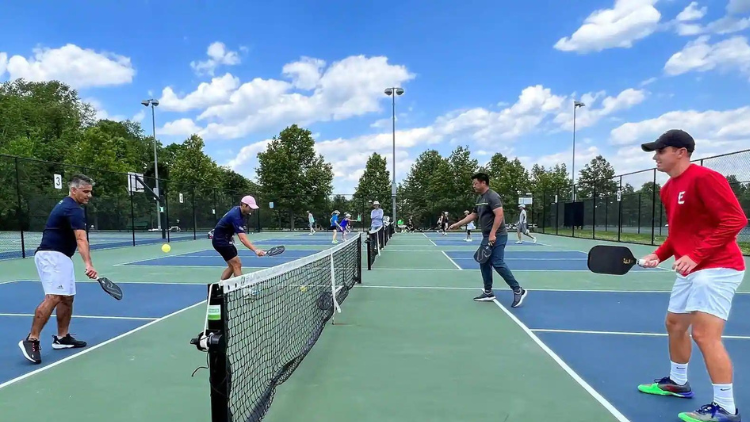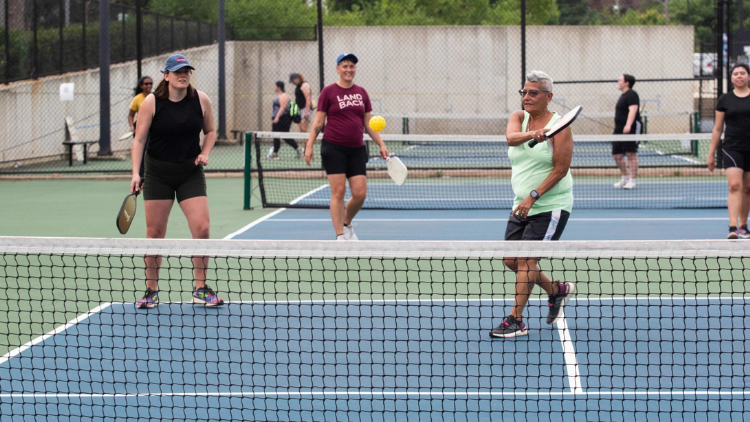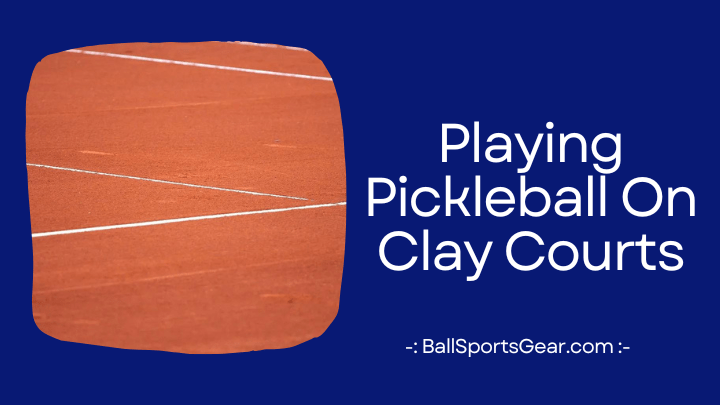Are you a pickleball fanatic who loves to try out new court surfaces? If yes, then have you ever considered playing on clay courts? This unique surface may be popular in tennis but is it possible to play competitive and enjoyable games of pickleball on clay too? In this blog post, we’ll explore the feasibility of playing pickleball on clay courts and reveal what makes this surface so different from others and also how much does it cost to build a pickleball court. So, let’s get ready for some fun-filled and informative insights.
Using Clay Courts For Pickleball
Pickleball is not typically played on clay courts because the surface is too soft and can be difficult to move on. Hard courts, such as those made of concrete, asphalt, or acrylic, are typically where pickleball is played. Because of the surface’s softness and potential for traction and movement problems, pickleball is typically not played on clay courts. Hard courts made of concrete, asphalt, or acrylic are frequently used for pickleball games.
It can be hazardous during frantic pickleball matches for players to slip or slide due to the clay court’s soft surface. A clay court’s surface is also more prone to deterioration than a hard court, which can lead to uneven surfaces that can also impact gameplay. If you’re looking for a court to play pickleball, it’s best to look for a hard court that has been specifically designed for the sport. These courts are typically marked with pickleball lines, which can help players stay within the boundaries of the court.
Additionally, they are often equipped with nets that are the correct height and width for pickleball play. It’s best to look for a hard court that has been created especially for pickleball if you’re looking for a court to play on. Pickleball lines are typically used to delineate the boundaries of these courts, making it easier for players to stay within them. They frequently have nets that are the right size and height for pickleball play as well.
What kind of surface do you usually play Pickleball on?
There are three main types of Pickleball courts: hard, soft, and clay. Hard courts are typically made of concrete or asphalt and are usually the most common type of court. Soft courts are typically made of synthetic materials such as rubber or turf. Dirt, sand, or gravel are used to construct clay courts.
In recent years, clay courts have gained popularity. Many players prefer clay courts because of their unique challenges. Playing on a clay court can be very different from Clay courts are the least common type of court, but they are gaining popularity in recent years. Clay courts provide a unique challenge to players. Playing on a clay court can be quite different from playing on a hard or soft court. Players need to adjust their game to accommodate the slower surface, as clay tends to hold on to the ball more than other surfaces.playing on a hard or soft court. Clay is a slower surface, so players must adjust their game accordingly. Clay also tends to hold onto the ball more than other surfaces, so players must avoid overhitting their shots.
Even with these difficulties, playing on clay courts can be a lot of fun. We urge you to try out playing on one if you have the chance!

How is playing Pickleball on a clay court different from playing on other surfaces?
Clay courts are a unique surface to play Pickleball on and offer a different set of challenges than other types of courts. Here are some things to keep in mind when playing Pickleball on clay:
- There will be less bounce on clay than on a hard court, so you’ll need to adjust your game accordingly.
- Wear traction-enhancing shoes when playing on clay courts.
- The clay can also cause the ball to roll more slowly, so you’ll need to be patient and strategic in your shots.
Overall, playing Pickleball on clay can be a fun and challenging experience. Just be sure to keep these things in mind and you’ll do just fine!
Can You Play Pickleball on a Clay Court?
In the pickleball world, clay courts are becoming increasingly popular. Many players like the challenge of playing on a surface that is not as forgiving as concrete or asphalt.
Compared to other surfaces, clay courts might be more difficult to maintain dry. The court may be extremely slick and hazardous to play on if it is wet. Before to playing, take careful to inspect the court’s condition. On clay courts, the ball bounces differently than on other surfaces, so it is important to experiment with different shots and strokes to see how the ball reacts. Trial and error is the best way to learn.
You should warm up thoroughly and stretch before playing on clay courts. The uneven surface can cause joint pain and other injuries if you are not careful. If you warm up properly and take precautions, playing pickleball on a clay court can be a fun and challenging experience.
What are the benefits of playing Pickleball on a clay court?
Playing Pickleball on a clay court provides many advantages that you won’t find on hard courts. Thanks to their superior drainage, these courts are easier to maintain and allow players to relax and focus on learning the game without being concerned about potential damage. Also, due to its slower nature, playing on clay helps lessen the impact on players’ joints and muscles.

What are the Different Types of Pickleball Courts?
Pickleball courts come in three different varieties: permanent, outdoor, and indoor. While pickleball courts outdoors might have surfaces made of concrete, asphalt, or even dirt, indoor pickleball courts are often composed of wood or tile.
It is common to find permanent local pickleball courts in public parks and recreation areas, usually made of concrete or asphalt and with a permanent net system.
The Pros and Cons of Playing Pickleball on a Clay Court
While clay courts have some benefits, there are also some drawbacks that you should be aware of before choosing to play pickleball on one.
Benefits of playing pickleball on a clay court include:
- For those just learning the game or those who want to take a break from the faster-paced games on hard courts, clay courts offer a slower pace of play.
- The softer surface of a clay court is easier on the joints and muscles, making it a good choice for players with joint or muscle pain.
- The warmer temperature of most clay courts can make playing pickleball more comfortable in cooler weather.
Drawbacks of playing pickleball on a clay court include:
- Hard court players may find the slower pace of play frustrating.
- Clay courts can be more difficult to keep clean than hard courts, so they may require more maintenance.
- Because they are typically located outdoors, clay courts may not be available to play on during inclement weather conditions like rain or snow.
How to Build a Clay Pickleball Court
Building a clay pickleball court is a great way to get the game going in your backyard or local park. Here are the steps you’ll need to take:
- Initially, you must locate a level plot of ground that is at least 60 feet by 30 feet in size. If you have more space, you may expand the court even farther.
- Once the boundary of the court has been marked with string or chalk, outline the playing area with a garden hose.
- It’s now time to begin constructing the court itself. You must first dig a trench all the way around the court to do this. 12 inches broad and 6 inches deep should be the pickleball court dimensions of the trench.
- Once the trench is dug, fill it with gravel and tamp it down so that it’s level with the surrounding ground.
- Next, lay down a layer of landscape fabric over the gravel to help prevent weeds from growing through.
- Now you can start adding in the clay material. The thickness of the clay layer will depend on how soft or hard you want the playing surface to be (usually between 4 and 8 inches). Once you have added the desired amount of clay, wet it down and compact it so that it’s nice and level.
- The last step is to add your net
Frequently Asked Questions
A clay court’s surface might not be the best for pickleball players since it can be dangerously slick and dangerously dangerous. On clay, it may be difficult for players to move fast or change direction, which increases the chance of falls and twisted ankles. Pickleball players are often advised to play on surfaces created expressly for the game, such as hard courts (either indoors or outdoors) or synthetic grass courts.
Yes, outdoor and indoor pickleball can be played on a clay court, but it may not be the best surface option due to its slippery and uneven nature. It is recommended to use surfaces specifically designed for pickleball to ensure optimal gameplay and player safety.
Yes, playing pickleball on clay courts can be more difficult due to its slippery and uneven nature, which can make it challenging for players to move quickly and change direction. However, with practice and the right equipment, players can adapt to the surface and still enjoy the game.
Conclusion
Pickleball can be an enjoyable experience even on clay courts, with the right strategy and preparation. Make sure you have the correct footwear and aim to perfect your tactics for maneuvering around the court. With these tips in mind, you can take your game to new heights and challenge yourself on a different surface.

